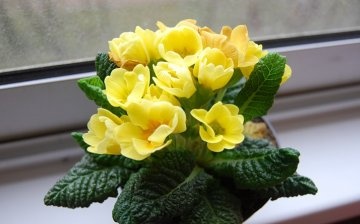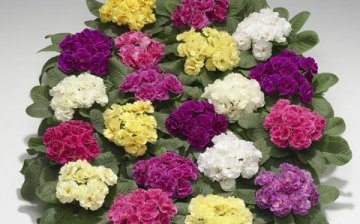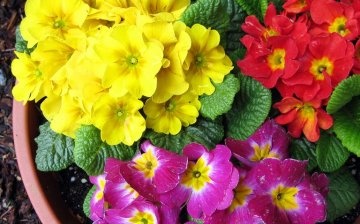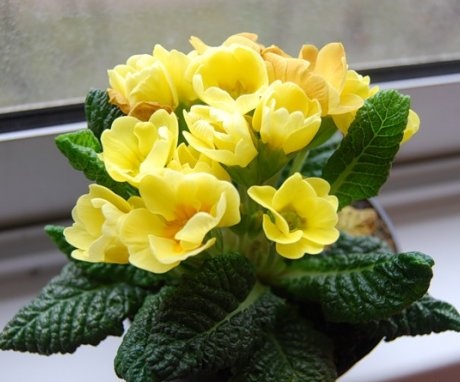High-quality care for room primrose
Primula is a member of the Primroses family. This family is quite extensive and includes about 500 species. Primrose is translated from Latin as "first". And this is not an accidental name, because its flowers appear first in the gardens after winter. The keys of the goddess of spring Freya - so the ancient Greeks called primrose because of its early flowering.
Content:
- Spreading
- Description
- Usage
- Primrose care
- Watering
- Top dressing
- Reproduction
- Landing
- Pests and diseases
Spreading
Distribution area primroses quite extensive: Europe, Asia, North and South America, Africa, China. She is also found on the island of Java.
Description
Primula is a stemless perennial plant whose wrinkled leaves are collected in a rosette. The root of the primrose is ground.
Its flowers reach 7 centimeters in diameter. They can be solitary or gather in the inflorescences of the brush or umbrellas. Their petals are blue, purple, red, yellow, or white.
Usage
Primrose is mainly used as an ornamental plant. But it is also used by traditional medicine as an expectorant for the treatment of vitamin deficiency. Previously, it was used to treat scurvy, fever and consumption.
Primrose care
Most often we see the multicolored primrose in the flower beds. This flower is one of the first to meet spring and one of the last to see off warm autumn days. But you can grow this beautiful flower at home. Primrose care room room will allow you to get a decent interior decoration with the help of beautiful flowers of different colors and shapes.
But it blooms in the room from late December to mid-May.
For normal growth and flowering, the plant needs ventilation. Without regular airing, gray mold appears on primrose. But at the same time, drafts are contraindicated for her.
The main requirement of primrose for growing and beautiful flowering at home is good lighting in the room. In principle, this indoor flower will grow successfully on windows of any orientation, you just need to take into account that primrose is not a lover of sun tanning, and therefore it must be protected from direct sunlight. The temperature, comfortable for primrose growth, is about 20 degrees. But since primrose is a subwinter flower, it will bloom profusely and for a long time it will be at a cooler temperature - about 15 degrees. If the temperature is too high, the bloom will not last long. You can create a suitable temperature for primrose on a windowsill that faces any side of the world, except for the south.
Watering
For successful growth and flowering, primrose must receive regular abundant watering, but without stagnant water in the pan. This flower does not like dampness and can rot and die. Like most houseplants, primroses need more watering during hot periods and less watering during cold weather.
Spraying primrose is not required. But if the humidity is too low, the leaves begin to dry out.
Top dressing
After the first buds appear, you need to start feed primrose. The flower is fed 2 times a month with diluted liquid fertilizer for flowers.
You do not need to fertilize the primrose before the buds appear. Otherwise, you will not see flowers: only leaves will grow.
Reproduction
You can propagate primrose using seed or by dividing the bush.Axillary shoots can be rooted.
Seeds are sown in soil, for the preparation of which fertile soil and sand are mixed. Then the seed boxes are left in a cool place.
After 2 weeks, when shoots appear, the boxes are rearranged to the light.
When 2-3 leaves appear on young plants, they are transplanted into separate pots. The pots are placed in a cool, ventilated area. Plants require regular watering and feeding.
When the first buds appear on young primroses, they need the same care as adult plants.
For the purpose of reproduction, the bushes are divided during transplantation.
Landing
After flowering, you should cut off the flowering shoots and transplant the primrose into new soil, dividing the plant into several bushes. The soil must be well-drained and loose. To prepare it, I mix peat, leaf and turf soil in equal amounts.
Pots with flowers are placed in a room with a temperature of 5-8 degrees, it is possible in the basement. In December, primrose is brought into the room. You can also plant primrose in open ground.
Pests and diseases
Indoor primrose can be affected by spider mites. Signs of this disease are yellowing and falling of the leaves of the plant. For treatment, it is necessary to use suitable preparations for indoor plants in compliance with the dosage and treatment regimen.
Also, primrose can be attacked by nematodes, weevils, slugs, beetles and flea beetles.
Another pest of primrose is aphid. Primrose leaves, when affected by this pest, become clumsy, fall off, the plant gradually loses its appearance and dies.
As it turns out, caring for room primrose is simple, you just have to choose a suitable place for the plant, water and feed on time so that it pleases with its beautiful flowering.













